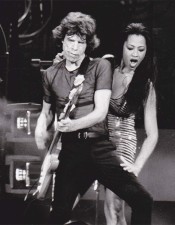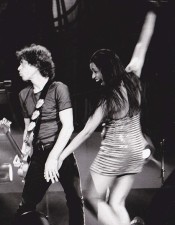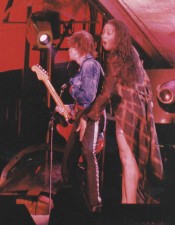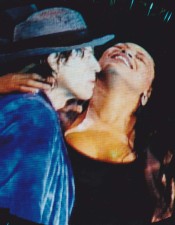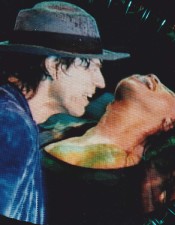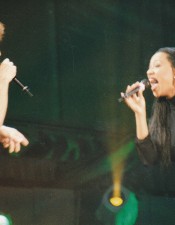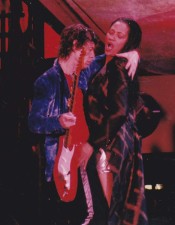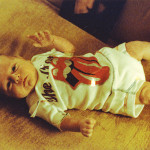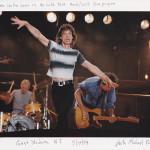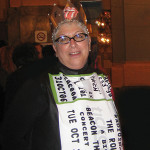The delightful and delicious diva Lisa Fischer is no stranger to Rolling Stones fans who have seen – and definitely heard – her singing backup vocals on every tour with the band since 1989.
She was 30 years old when she first stood on the platform (stage right), where today on the Grrr! 50 & Counting tour she still gloriously sings her heart out and reveals a piece of her soul every night when backing the Greatest Rock ‘n Roll Band in the World.
Although backup singers are expected to remain anonymously in the back ground, you can’t help watching Lisa and her partner, the melodic Bernard Fowler, as the two sexiest contributors to the Stones rock ‘n roll circus croon with moxie and shimmy with choreographed moves.
And then you really take notice of Lisa when she owns the stage and takes over the spotlight from Mick Jagger during their “Gimme Shelter” duet. Nobody sings it better live, even though some special female guest stars tried very hard to live up to the Lisa legacy.
Lisa is easily living up to the incredible legacy that Merry Clayton began on November 3, 1969, when she was summoned to Sunset Sound Studios in the middle of the night to add a female voice to “Gimme Shelter”. With her ferocious sound, Merry nailed it on the first take and then laid down two more for good measure, with “rape, murder — it’s just a shot away” becoming iconic rock vocals and lyrics.
Both Lisa Fischer and Merry Clayton talk about their backing vocal careers in the documentary Twenty Feet From Stardom from director Morgan Neville. He spotlights the untold and oft-ignored story of the backup singers behind many of the greatest musical legends of the 21st century. The movie won an Academy Award for Best Documentary Feature.
The film centers on the performers’ struggles and triumphs as professional musicians who are required to relinquish the limelight to the stars they sing behind, by some 20 feet. It opened in theatres June 14.
Lisa Fischer “couldn’t wait to meet her” and hugged and kissed Merry Clayton on the mouth when the two divas met for the first time at the film’s opening at the Sundance Film Festival (where it was nominated for a grand jury prize and got a standing ovation). That’s where Lisa watched the film for the first time and she and the audience sat in awed silence during the stirring scene where Merry, 64, sits in the same LA studio where “Gimme Shelter” was recorded.
Merry recounts how she arrived wearing a mink coat over her pajamas with her hair in curlers and describes the song’s session. She quietly listens to the track with her background vocals blaring, and satisfaction, pleasure and pride reflecting on her entire countenance. The Sundance audience burst into spontaneous applause after the segment. And in a parallel scene in the film, Mick Jagger tears up as he emotionally listens only to her vocals as they reach their incredible heights.
I saw the documentary in Philadelphia at the WXPN Music Film Festival where Lisa made an appearance afterwards with another background singer from the film, Darlene Love, who was a key voice in producer Phil Spector’s “Great Wall of Sound.” They were two of the main artists featured in the documentary that reflects on the heartache and rewards of their industry. The film also features (among others): Judith Hill, who sang with Michael Jackson and was a recent finalist on The Voice; Tata Vega, who tours with Elton John; Cindy Mizelle, background singer with Luther Vandross; and Jo Lawry, Sting’s featured backup.
But it is our own Lisa Fischer who is the reluctant star of the film, which is so very ironic because she was one of the few back up singers who profess not to want to be a star in her own right. She explains how she loves her career harmonizing with others.
“Part of the beauty of it is that you’re invisible,” Lisa told me in her suite in the Peninsula Hotel when the Stones were performing in Chicago, before the Oscar nomination. “It’s not about you. It’s about being selfless, and that to me is the most joyous thing.”
In her beautiful, breathy speaking voice, Lisa shared her journey to joy. With a giggle she explained that she remembers the exact occasion of her epiphany. It began in pre-K when she was walking to school in her Fort Greene neighborhood of Brooklyn, holding her mother’s hand.
She saw a piece of paper on the ground with some kind of symbols on it, and in her little-girl mind she interpreted them as being music notes. Her mother fussed when she picked it up but Lisa was determined. She took the paper to her teacher and told her, “I wrote a song and I want to sing it to class” and proceeded to sing her made-up-on-the-spot song.
“I wouldn’t shut up,” Lisa laughs as she remembers. “I thought ‘this is fun’ and I was bitten.”
Her love of singing continued to be fostered by her mother, a homemaker, her father, a security guard and warehouse worker, and two younger brothers, who all sang together around a piano, especially during the Christmas holidays.
“Music has always been my best friend and it’s a timeless world I can step into and be safe,” she said. “When I sing I’m in my safe zone. It heals me and I never tire of it.”
Her devoted fans run the gamut through all of her vocal genres, from rock ‘n roll, to R&B, soul, jazz and pop. In concerts and/or recording studios, Lisa has backed up Tina Turner, Luther Vandross, Chaka Khan, Sting, Dolly Parton, Beyoncé, Alicia Keys, Aretha Franklin, Chris Botti and Rolling Stones back-up musician Tim Reis. She is also on several studio and live albums with the Stones.
Lisa had her own fifteen minutes of fame in 1992 when she won a Grammy for Best Female R&B Vocal Performance for her first single, “How Can I Ease the Pain,” from her album So Intense. She beat out the “Queen of Soul” Aretha Franklin and tied with Patti LaBelle, who was also given a golden gramophone in the same category. The documentary shows a visibly touched Lisa accepting the award in an alluring black gown with a huge feather collar.
She never made another solo record after that. In the film (and in our interview) she down-plays the need for wanting, or needing, the limelight.
“Albums take so long to do and when you’re making them you have to know what kind of singer you are, what direction you want to go in, what your style is. I didn’t want people deciding for me, I didn’t want to do all that any more,” Lisa said. “I just want to do music that makes me feel good. And in order to do that I’ve gotten out of my own way.”
Lisa continued, animated with conviction. “I’ve spent my whole life not being the nucleus, and that suits me perfectly. It’s most important that I have the temperament for the greater good, and that applies across the board. Something about the female energy lends itself to be able to support.”
Her early career had an electronic dance phase in the ‘80s, when she recorded a freestyle demo “On the Upside” and had club gigs under the stage name “Xēna.” In 1983 Lisa got her big break and was hired by Luther Vandross as a backup singer, working with him until his death in 2005. The R&B singer became her mentor and he taught her the subtleties and nuances vital to becoming the music industry’s reigning backup queen that she is today.
Her beautiful brown eyes get a bit teary when she notes how thankful she is for his friendship and advice on things that a good backup singer needs to know, like how to put any ego aside and mesh her identity with the other background singers on the line. Twenty Feet from Stardom has lots of great footage of Lisa’s evolution to the voluptuous vocalist that she is today. One scene I especially enjoyed for her stage style was Lisa wearing a sequined jumpsuit while singing for Luther and adding some fierce dance moves and spins.
“I sucked when I started, you hear me? I sucked!” she said with a laugh. But she quickly came up to speed under Luther’s tutelage and learned to adapt any required stage personas. “Fans would tell me ‘I thought you’d be a bitch’ but you’re really nice,” her laughter growing.
There are so many endearing ways to describe the caring, loving, kind and, yes, nice, Lisa Fischer. When she committed to the film she said she knew that the producer and famed music executive, the late Gil Friesen, who died suddenly at 75 a month before its premiere, would “be wonderful and gentle if I trusted him with my heart.”
The film reveals Lisa to us on a very intimate level. Wrapped in a sweater, sans make up, with her hair short and twisted into little dreadlocks, she leads viewers into her New Jersey loft that’s partially under construction and shows us the art she eventually wants to hang on her walls. Lisa cracked up as she told me how that scene got filmed. She was surprised to have the camera crew show up at her door ready to shoot the footage because she misunderstood their intent. And she was too nice to send them away.
The documentary also clearly reveals Lisa’s aspirations to purely harmonize, and it sets her apart from the other background singers who anxiously aspired to stardom. Those artists span a range of styles, genres and eras of popular music, but each has a uniquely fascinating and personal story to share of life spent in the shadows of superstardom.
In the press notes, director Morgan Neville states: “Most often the object was to meld perfectly in what everybody called “The Blend”—an almost spiritual state of harmony, where there is no individual identity. To me this seemed at the essence of the experience of backup singing. It’s soulful care giving, with few rewards. For some, this is bliss. For others, it’s purgatory.”
With “The Blend” perfected, many of the singers sought those elusive rewards, but others were satisfied with a career built on blending, like the Waters Family, who recorded background vocals for Michael Jackson, Paul Simon, Patti LaBelle, and Donna Summer.
“Everyone’s story is so honest and so different and each has a lesson. There is no right or wrong way to do this,” Lisa said. “I know that I’ll never be Merry Clayton but I will be the best I can be.”
There is a wonderful section of the film devoted to Merry Clayton’s solo career with footage of her performing on the TV show “Soul Train.” Most of the other singers in the film also aspired to be in the spotlight and released their own albums, including: Tata Vega, Claudia Linnear, and a former Ray Charles’ Raelette signed to Stax and Motown, Dr. Mable John.
Stardom was also elusive for Darlene Love with her dreams of a solo career continuously thwarted by Phil Spector’s efforts to keep her in the background, where she sang catchy background lyrics like “da doo ron, ron” and “shoop, shoop.” Instead of becoming a household name, Love wound up cleaning houses to make ends meet. But in a counterpoint to the heartbreak, the film also shows the singer, now in her 70s, reuniting with her band mates from the Blossoms for the first time in four decades and enjoying a resurgence in her career.
Along with rare archival footage and an amazing, unrivaled soundtrack, Twenty Feet From Stardom has interviews with those twenty feet ahead of aspirant stardom: Bette Midler, Stevie Wonder, Mick Jagger, Sting, Sheryl Crow and Bruce Springsteen, among others, take a backseat in the film to the diverse assortment of backup singers whose lives and stories take center stage.
The superstars share their love and admiration and sing praises for the performers who support them, but it is Lisa Fischer who is the most gushed about, even by her colleagues. And she is touched and humble about the accolades when I remind her about them.
Asked about her career pinnacle, she gives the answer any backup singer would be in rapture to give – The Rolling Stones, of course.
It all began when Mick Jagger’s publicist, Tony King, saw Lisa perform with Luther Vandross at Madison Square Garden. King brought her to Mick’s attention and when Lisa auditioned, Mick put her demo tape into a boom box and asked her to sing. Then the front man started to dance around her, which Lisa thought was weird, but she didn’t get thrown off and kept right on singing. She attributes her composure with getting her the gig of a lifetime.
“I grew up on stage with them,” she said with a huge smile. “After 25 years I’ve watched them grow as people and my life has been enhanced because of working with them and being with them. It’s a gift really.”
Okay then, I want to know what it’s like to grind Mick Jagger onstage every night? And how can I apply for your job? She laughs and says, “it’s fun, it’s playtime on stage, a performance. I know not to break his flow, to meet him with the energy he gives me. And off stage it’s very mutually respectful.”
Lisa concedes that “(The Rolling Stones) could have asked anybody to sing with them. It’s an honor to be part of their sound.” From any proximity.
Feature photo by Djeneba Aduayom
Gallery photos from: Love You Live, Rolling Stones: Fanfare from the Common Fan © 2002



 05 Mar 2014
05 Mar 2014

